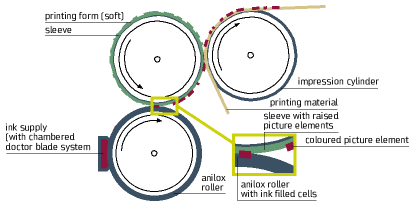Digital Printing has the same capabilities as Litho Printing but at a lower quality. Digital Printing is good for low volume runs that require complex graphics printed.
 |
| http://www.inhousedesign.co.nz |
Screen Printing
A printing process whereby ink is forced through a fine mesh stretched across a frame. It is ideal for printing onto Polypropylene, Plastics, Correx, PVC or Aluminium where the design requires solid colours.
Varnishes can also be applied by this method.
Colour flooding is achieved by screen printing, allowing you to create a colour finish across the product.
Fine tints and tones are not possible with this process.
 |
| http://www.behance.net/gallery/Shapes-Screen-Print/6531487 |
Lino Printing
Linocut is a printmaking technique, a variant of woodcut in which a sheet of linoleum is used for the relief surface.
A design is cut into the linoleum surface with a sharp knife, V-shaped chisel or gouge, with the raised areas representing a reversal of the parts to show printed.
The linoleum sheet is inked with a roller, and then impressed onto paper or fabric. The actual printing can be done by hand or with a press.
 |
| http://www.behance.net/gallery/Work-Hard-Make-Luck/12002565 |
Letterpress
Letterpress printing is a technique of relief printing using a printing press.
A worker composes and locks movable type into the bed of a press, inks it, and presses paper against it to transfer the ink from the type which creates an impression on the paper.
Letterpress printing was the normal form of printing text from its invention by Johannes Gutenberg in the mid-15th century until the 19th century and remained in wide use for books and other uses until the second half of the 20th century.
Letterpress printing remained the primary way to print and distribute information until the twentieth century, when offset printing was developed, which largely supplanted its role in printing books and newspapers.
 |
| http://www.behance.net/gallery/2014-Letterpress-calendar-The-creative-manifesto/11753895 |
Laser Cutting
Laser cutting is a technology that uses a laser to cut materials, and is typically used for industrial manufacturing applications.
Laser cutting works by directing the output of a high-power laser, by computer, at the material to be cut. The material then either melts, burns, vaporizes away, or is blown away by a jet of gas, leaving an edge with a high-quality surface finish.
 |
| http://www.behance.net/gallery/Visual-Language/11101117 |
Litho printing
Of all the methods of applying ink to paper, litho printing achieves the sharpest definition.
It has very few limits. It is able to recreate shading and tones ranging from deep black to the softest grey, as well as all colours in between. It can even mimic the artistic effects of drawing and painting.
Hundreds of top quality prints can be taken from a single plate, making litho a hugely successful commercial application for the printing of magazines, brochures, cards, photography and many other promotional and graphic materials.
In fact, because photography, full colour graphics and text are all improved with an offset print, the commercial scope of litho printing is practically unlimited.
Offset Litho printing
Offset lithography is a process used for printing on a flat surface, using printing plates. An image is transferred to a printing plate, which can be made of a variety of materials such as metal or paper.
The plate is then chemically treated so that only image areas (such as type, colors, shapes and other elements) will accept ink. Water and ink is applied to the plate. Because of the chemical treatment, ink only "sticks" to the image areas, which reject the water. Areas without images reject the ink.
The plate is then rolled onto a rubber cylinder applying the inked area, and in turn the rubber cylinder (or "blanket") applies the image to the paper. The system is "offset" because the plate does not come in direct contact with the paper, which preserves the quality of the plate.
Flexo Printing
Frequently used for printing on plastic, foil, acetate film, brown paper, and other materials used in packaging, flexography uses flexible printing plates made of rubber or plastic.
The inked plates with a slightly raised image are rotated on a cylinder which transfers the image to the substrate. Flexography uses fast-drying inks, is a high-speed print process, can print on many types of absorbent and non-absorbent materials, and can print continuous patterns (such as for giftwrap and wallpaper).
Some typical applications for flexography are paper and plastic bags, milk cartons, disposable cups, and candy bar wrappers. Flexography printing may also be used for envelopes, labels, and newspapers.
Rotogravure printing
With gravure printing an image is etched on the surface of a metal plate or cylinder so that the image you want to print is in the recesses or depressions not the raised part of the plate (unlike relief printing where the image is raised).
The recesses are filled with ink and the raised (non-printing) portions of the plate or cylinder are wiped or scraped free of ink leaving the ink only in the recesses.
The paper or other material is pressed against the inked plate or cylinder and the image is transferred to the paper.
It can produce fine, detailed images and can be used for short or long run printing. It can be used for CMYK printing with each color of ink applied with its own plate or cylinder with drying steps in between.
Sources



No comments:
Post a Comment